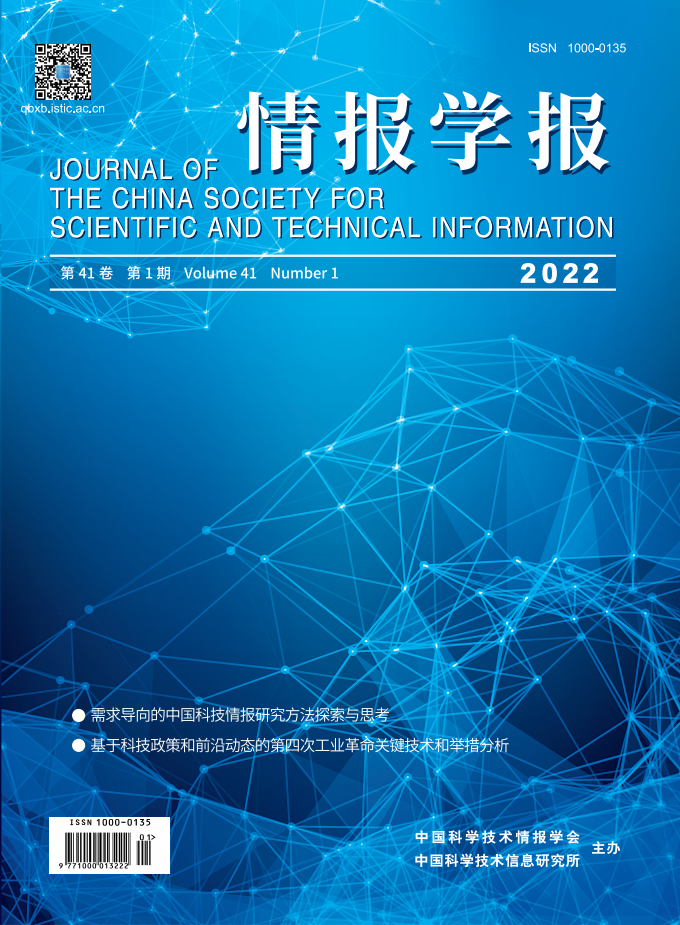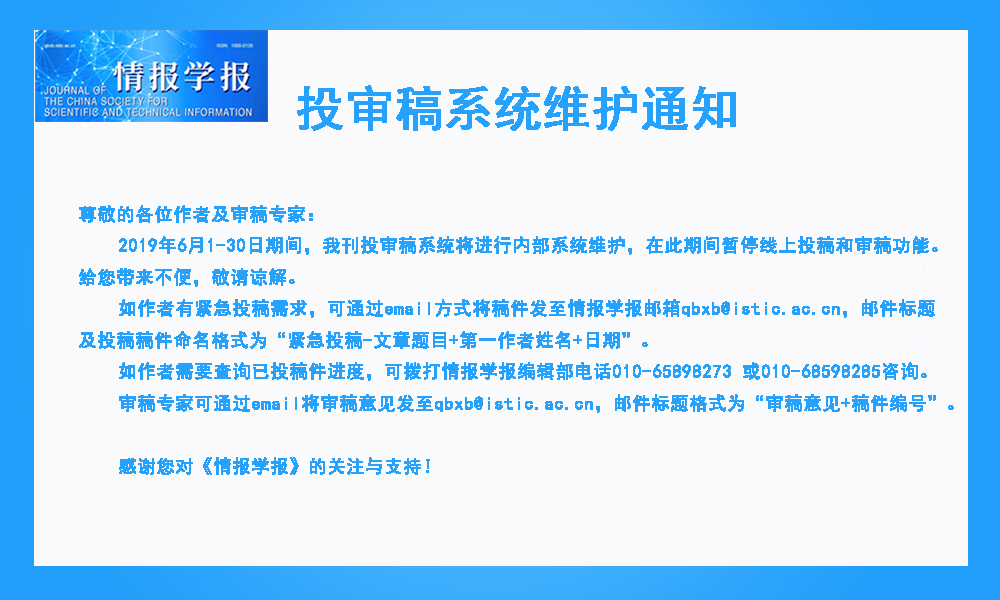 |
|
2022 Vol. 41, No. 1
Published: 2022-01-24 |
|
|
| |
|
|
|
|
|
18 |
Construction of Emergency Intelligence Support System for Government Think Tanks during Emergency Events Hot! |
|
 |
Huang Xiaobin, Zhang Mingxin |
|
|
DOI: 10.3772/j.issn.1000-0135.2022.01.003 |
|
|
This study aims to understand the components, interrelations, and existing problems of the emergency intelligence support system of Chinese government think tanks in emergencies, to provide inspiration for government think tanks to improve the quality of the emergency intelligence support system. Taking 33 government think tanks as cases, this paper examines various types of data released by the 33 think tanks during the Q event and constructs the emergency intelligence support system based on grounded theory. Emergency participants, emergency supporting objects, emergency intelligence needs, emergency supporting content, and emergency supporting processes are the components of the emergency intelligence support system of government think tanks. Emergency intelligence needs are the driving force, emergency participants are the thrust, and emergency supporting objects are the pulling force. The process and content of the emergency intelligence support system are closely related, forming the core of the emergency intelligence support system. Combined with the research results, this study puts forward some suggestions, such as integrating the crowdsourcing mode, encouraging public participation, introducing emerging information technology, and enhancing the coordination of emergency participants. |
|
|
2022 Vol. 41 (1): 18-28
[Abstract]
(
189
)
HTML
(106 KB)
PDF
(1558 KB)
(
485
) |
|
|
|
29 |
Analysis of Key Technologies and Measures of the Fourth Industrial Revolution Based on S&T News Mining Hot! |
|
 |
Wang Yanpeng, Wang Xuezhao, Chen Xiaoli, Li Yizhan, Liu Xiwen |
|
|
DOI: 10.3772/j.issn.1000-0135.2022.01.004 |
|
|
To fully grasp the historical opportunities of the Fourth Industrial Revolution, countries worldwide will inevitably aim at the strategic Science and Technology (S&T) field and use several key technologies as the starting point to launch a series of policies, strategies, plans, and specific measures to promote S&T progress and change, to occupy the first mover advantage in the fourth industrial revolution. The article uses important news texts such as science and technology policy strategies and research and development (R&D) progress released by major countries in recent years as the analysis object. Further, it uses natural language processing (NLP), text mining, and scientometrics to reveal the key fields, technologies, and initiatives that countries are concerned about in the fourth industrial revolution. The study found that major countries focus on S&T fields such as biology and agriculture, materials, aerospace, digital communications, energy, marine, traditional manufacturing, while actively deploying key technologies such as quantum computing, artificial intelligence, renewable energy, nanotechnology, genetic technology. Additionally, major countries adopt investment plans, cooperative research, policy research, and research projects to promote the development of the aforementioned S&T fields and key technologies. Starting from the text mining of news texts, the article sorts out the layout of S&T fields, key technologies, and key measures of major countries in the fourth industrial revolution. From a theoretical standpoint, it expands the application scenarios of NLP, text mining, and scientometrics in S&T policy research. From a practical standpoint, it provides information and reference for our deployment of strategic S&T fields and key technologies, and implementation of initiatives. |
|
|
2022 Vol. 41 (1): 29-37
[Abstract]
(
269
)
HTML
(82 KB)
PDF
(3178 KB)
(
508
) |
|
|
|
38 |
The Evolution Law of International Technology Trade Pattern: The Perspective of Data Analysis of Charges for the Use of Intellectual Property Hot! |
|
 |
Feng Zhigang, Zhang Zhiqiang, Liu Hao |
|
|
DOI: 10.3772/j.issn.1000-0135.2022.01.005 |
|
|
From a global perspective, this study explores the evolution of the pattern of international technology trade activities over a significant period. This study selects the data of charges for the use of intellectual property of 50 major countries (regions) from 1970 to 2019 as the analysis object. Subsequently, it uses the gravity center model, science center transfer theory, and complex network analysis method to analyze the geographical gravity center transfer, center country (regions) transfer order, and network structure evolution of international technology trade from import and export perspectives. From 1970 to 2019: (1) The import and export geographical gravity centers of international technology trade were stable in the northern hemisphere, and moved eastward at the speed of 0.56 degrees (45.19 km) per year and 1.52 degrees (120.68 km) per year; the import gravity center was consistently located to the east of the export gravity center, but the distance between them was gradually narrowing. (2) The transfer order of the import center of international technology trade is Germany → Japan → the United States → the Netherlands → Ireland; the export center has not been transferred, and it has always been the United States, but its proportion continues to decline. (3) International technology trade activities are becoming increasingly extensive and deepening; the international technology trade network has obvious “small world” and “core-edge” structural characteristics; the dominant position of the United States is still obvious, with the strongest technology trade profitability; China’s network status has rapidly improved, but the export capacity of technology trade needs to be improved. |
|
|
2022 Vol. 41 (1): 38-49
[Abstract]
(
131
)
HTML
(147 KB)
PDF
(3977 KB)
(
428
) |
|
|
|
50 |
Automatic Mapping Method and Empirical Research of U.S. Commerce Control List Data and Patent Data Hot! |
|
 |
Lyu Lucheng, Han Tao, Chen Fang, Wang Xuezhao, Zhao Yajuan, Guo Shijie |
|
|
DOI: 10.3772/j.issn.1000-0135.2022.01.006 |
|
|
To efficiently reveal the technology gap between China and the United States in technologies recorded in the U.S. Commerce Control List (CCL), under the circumstances of the highly unstructured characteristics of CCL data, this paper proposes an automatic method to map the CCL and patent data, which can automatically reveal the technology gap from the perspective of the patent. Based on the theory of text mining, the text standardization process of CCL text is formulated, and the automatic mapping method and effect evaluation indicator of CCL data and patent data based on TF-IDF and Word2Vec are proposed. Taking the U.S. CCL data in 2019 and the global Patent Cooperation Treaty (PCT) patent application data in 2018 as an example, the empirical research is conducted. By evaluating the effect of the model, it is finally found that the automatic mapping result obtained when the text similarity threshold of Word2Vec model is 0.87 is optimal, and the technology gap analysis is carried out based on this model. The method proposed in this paper can automatically map CCL and patent data and carry out an intelligence analysis, and the analysis results are highly interpretable. It is a useful tool to improve the timeliness of intelligence analysis, and has high practical value. |
|
|
2022 Vol. 41 (1): 50-61
[Abstract]
(
164
)
HTML
(1 KB)
[PDF
(0 KB)
(
551
) |
|
|
|
62 |
Using Unsupervised Graphs of Neural Networks for Constructing Learning Representations of Academic Papers Hot! |
|
 |
Ding Heng, Ren Weiqiang, Cao Gaohui |
|
|
DOI: 10.3772/j.issn.1000-0135.2022.01.007 |
|
|
Constructing feature representations of academic papers is a key step in providing scholarly big data services, such as academic searches, literature classification and organization, and personalized paper recommendations. The current research shows that using graphs of neural networks can help researchers learn how to effectively construct representations of academic papers, but most have focused on a supervised learning approach, which requires massive amounts of high-quality data. Based on this context, in this study uses four unsupervised graphs of neural networks for learning to construct representations of academic papers using data from the Cora, CiterSeer, and DBLP datasets; then, the representations of the papers are applied to completing two downstream tasks, i.e., literature classification and paper recommendation. The experimental results show that: (1) deep graph infomax performs best for literature classification, and an adversarially regularized graph autoencoder exhibits better performance in paper recommendation; and (2) citation networks perform better than co-citation networks and literature coupling networks on the Cora dataset. |
|
|
2022 Vol. 41 (1): 62-72
[Abstract]
(
294
)
HTML
(215 KB)
PDF
(2371 KB)
(
795
) |
|
|
|
83 |
Grounded Research on the Impacting Mechanism of Satisfaction with Intelligent Information Recommendation Services by Digital Libraries Hot! |
|
 |
Zha Xianjin, Zhang Kun, Yan Yalan |
|
|
DOI: 10.3772/j.issn.1000-0135.2022.01.009 |
|
|
At present, the information environment of digital libraries has changed from lack of information to information overload. Thus, the corresponding service mode should accordingly be changed from “people looking for information” to “information looking for people.” The application of intelligent information recommendation services can be helpful in coping with the new challenges presented by the transformation of digital libraries. However, there is a lack of in-depth research on the impacting mechanism of satisfaction with intelligent information recommendation services by digital libraries at home and abroad. This study employs the grounded theory method to conduct coding analysis on original data obtained through interviews, eliciting 78 initial concepts, 24 basic categories. and 6 main categories. Based on these data, the relationship paths and mechanisms among categories are combed, and a theoretical model of the impacting mechanism of satisfaction with intelligent information recommendation services by digital libraries is developed. It is found that recommendation system quality, recommendation information quality, recommendation service quality, and recommendation form jointly affect satisfaction, with a moderating effect of user preference. The results of this research provide useful references for service optimization and the healthy development of digital libraries and also offer theoretical and practical implications. |
|
|
2022 Vol. 41 (1): 83-95
[Abstract]
(
264
)
HTML
(146 KB)
PDF
(1324 KB)
(
766
) |
|
|
|


